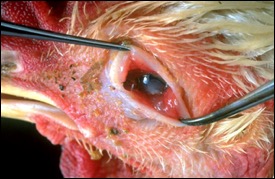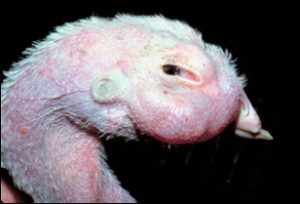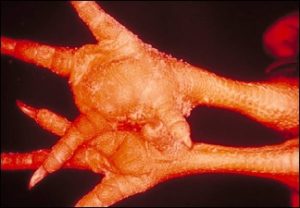Mycoplasmosis in Backyard Chicken Flocks
Martin Ficken, DVM, PhD
Mycoplasmosis, caused by Mycoplasma gallisepticumand/or M. synoviae, is a group of bacterial diseases that are common maladies of backyard chicken flocks.
Mycoplasma gallisepticum (MG) is the most common upper respiratory infection of backyard chicken flocks. The characteristic signs of naturally occurring infections are watery eyes, tracheal rales, nasal discharge, and coughing (Figure 1). Feed consumption is reduced, resulting in weight loss. In adult laying birds, egg production often declines to a lower level or may cease in individual birds. Infections in younger birds are often more severe than older or adult birds. In uncomplicated infections, mortality is often low or negligible. However, infections complicated by respiratory viruses such as infectious bronchitis virus or Newcastle disease virus can result in a prolonged disease course and significant mortality.
In turkeys the disease is more severe as they are more susceptible. Clinical signs include watery eyes, severe sinusitis (Figure 2), respiratory distress, listlessness, reduced feed intake, and weight loss. As with chickens, infections complicated by Newcastle disease virus or Bordetella avium, result in more severe infections and an elevation in mortality.
Mycoplasma synoviae (MS) frequently occurs as a subclinical upper respiratory infection. Many times, MS becomes systemic and results in infectious synovitis, an acute to chronic infection of chickens and turkeys involving the synovial membranes of joints and tendon sheaths (Figure 3). However, when combined with other upper respiratory pathogens, as mentioned above with MG, significant upper respiratory disease can be observed. MS and MG often occur as a combined infection with severe upper respiratory disease observed.
Diagnosis of MG and MS can be done in one of two ways at the Texas A&M Veterinary Medical Diagnostic Laboratory (TVMDL). A real-time polymerase chain reaction (rtPCR) procedure is available that tests simultaneously for MG and MS. The test is conducted on tracheal and/or oropharyngeal swabs of clinically ill birds and is direct confirmation of the presence of the pathogen. A second indirect test can be performed on serum samples collected from birds that usually have been ill for a short period or have had clinical symptoms from which they have recovered. This serological test checks for antibodies to MG and a second test checks for antibodies to MS. If these tests are positive for antibodies, a presumptive diagnosis of mycoplasmosis is made.
For more information about this article, contact Gonzales Resident Director Dr. Martin Ficken. To learn more about TVMDL’s poultry test offerings, visit tvmdl.tamu.edu or call 1.888.646.5623.
References:
Raviv, Z, Ley, DH. Mycoplasma gallisepticum Infection in Diseases of Poultry, 13thedition, Wiley-Blackwell, ed. Swayne, DE et al. pp. 877-893, 2013.
Ferguson-Noel, N, Noormohammadi, AH. Mycoplasma synoviae Infection in Diseases of Poultry, 13thedition, Wiley-Blackwell, ed. Swayne, DE et al. pp. 900-906, 2013.

Figure 1 – Chicken with inflamed conjunctiva and watery eyes. A small amount of nasal exudate is present. Photograph courtesy of Dr. H. John Barnes, College of Veterinary Medicine, North Carolina State University.

